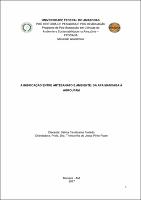| ???jsp.display-item.social.title??? |


|
Please use this identifier to cite or link to this item:
https://tede.ufam.edu.br/handle/tede/5799| ???metadata.dc.type???: | Dissertação |
| Title: | A imbricação entre artesanato e ambiente: da APA maroaga à AGROUFAM |
| ???metadata.dc.creator???: | Furtado, Selma Cavalcante  |
| ???metadata.dc.contributor.advisor1???: | Fraxe, Therezinha de Jesus Pinto |
| ???metadata.dc.description.resumo???: | O artesanato vem emergido com cada vez mais veemência na atualidade, e materializa a imbricação entre os aspectos subjetivos e objetivos dos variados grupos sociais. Desta forma, observando a imprescindibilidade do desenvolvimento de pesquisas relacionadas ao tema, o objetivo desta dissertação foi analisar a formação e o desenvolvimento do artesanato produzido pelas mulheres da APA Maroaga. A escolha da área de estudo partiu de uma demanda social, na qual os sujeitos da pesquisa solicitaram à universidade projetos que visam analisar o processo produtivo do artesanato e seus desdobramentos. Para atingir o objetivo proposto, foram utilizados diversos instrumentos metodológicos, como aplicação de formulários, entrevistas abertas e a Matriz de Benefícios e Entraves. O delineamento do desenho amostral foi de 100% das artesãs da APA Maroaga, que corresponde à um total de 04 mulheres. Os dados foram sistematizados no Programa Excel, que é um software utilizado para a criação de banco de dados e para a geração de gráficos e tabelas. Nesse sentido, as ferramentas metodológicas elencadas subsidiaram o alcance dos objetivos específicos e, consequentemente, do objetivo geral da pesquisa. Pode-se inferir, após a análise dos dados, que o artesanato, apesar de não ser a principal fonte de renda, exerce uma importância significativa na reprodução social das famílias artesãs da APA Maroaga. Os benefícios vão desde o incremento na renda mensal até a dimensão da reprodução simbólica da tradição da comunidade. Entraves também foram identificados, como dificuldades com o transporte dos artesanatos e o escasso apoio governamental, entretanto, a história das artesãs da APA Maroaga é uma história de resistência, na qual o sentimento de pertença e os aspectos simbólicos, existentes na confecção dos artesanatos, transpõe as barreiras enfrentadas. Portanto, pode-se afirmar que o artesanato tem sido um importante elemento de perpetuação das tradições, pois, por meio das técnicas utilizadas tem corroborado o etnoconhecimento, construído geracionalmente, e o reproduzido de maneira cíclica e transformadora. |
| Abstract: | Craftsmanship has emerged with increasing vehemence today, and materializes the imbrication between the subjective and objective aspects of the various social groups. Thus, observing the indispensability of the development of research related to the theme, the objective of this dissertation was to analyze the training and the development of the handicrafts produced by the APA Maroaga women. The choice of the study area was based on a social demand, in which the research subjects asked the university for projects that aimed to analyze the productive process of the crafts and their unfolding. To reach the proposed objective, several methodological instruments were used, such as application of forms, open interviews and the Matrix of Benefits and Obstacles. The design of the sample design was 100% of the artisans of APA Maroaga, which corresponds to a total of 04 women. The data were systematized in the Excel Program, which is a software used for the creation of databases and for the generation of graphs and tables. In this sense, the methodological tools listed have subsidized the achievement of the specific objectives and, consequently, of the general objective of the research. It can be inferred, after analyzing the data, that handicrafts, although not the main source of income, play a significant role in the social reproduction of APA Maroaga artisan families. The benefits range from increasing monthly income to the dimension of symbolic reproduction of the community tradition. However, the history of the artisans of the APA Maroaga is a history of resistance, in which the sense of belonging and the symbolic aspects, existing in the making of the handicrafts, have been identified as obstacles to the transportation of handicrafts and the lack of governmental support, Transposes the barriers faced. Therefore, it can be affirmed that handicrafts have been an important element in the perpetuation of traditions, since, through the techniques used, they have corroborated the ethnoconditioning, constructed generationally, and reproduced in a cyclical and transformative way. |
| Keywords: | Artesanato Feira da Produção Familiar |
| ???metadata.dc.subject.cnpq???: | CIÊNCIAS AGRÁRIAS |
| Language: | por |
| ???metadata.dc.publisher.country???: | Brasil |
| Publisher: | Universidade Federal do Amazonas |
| ???metadata.dc.publisher.initials???: | UFAM |
| ???metadata.dc.publisher.department???: | Faculdade de Ciências Agrárias |
| ???metadata.dc.publisher.program???: | Programa de Pós-graduação em Ciências do Ambiente e Sustentabilidade na Amazônia |
| Citation: | FURTADO, Selma Cavalcante. A imbricação entre artesanato e ambiente: da APA maroaga à AGROUFAM. 2017. 73 f. Dissertação (Mestrado em Ciências do Ambiente e Sustentabilidade na Amazônia) - Universidade Federal do Amazonas, Manaus, 2017. |
| ???metadata.dc.rights???: | Acesso Aberto |
| ???metadata.dc.rights.uri???: | http://creativecommons.org/licenses/by-nc-nd/4.0/ |
| URI: | http://tede.ufam.edu.br/handle/tede/5799 |
| Issue Date: | 29-May-2017 |
| Appears in Collections: | Mestrado em Ciências do Ambiente e Sustentabilidade na Amazônia |
Files in This Item:
| File | Description | Size | Format | |
|---|---|---|---|---|
| Dissertação - Selma Cavalcante Furtado.pdf | 3.76 MB | Adobe PDF |  Download/Open Preview |
This item is licensed under a Creative Commons License





